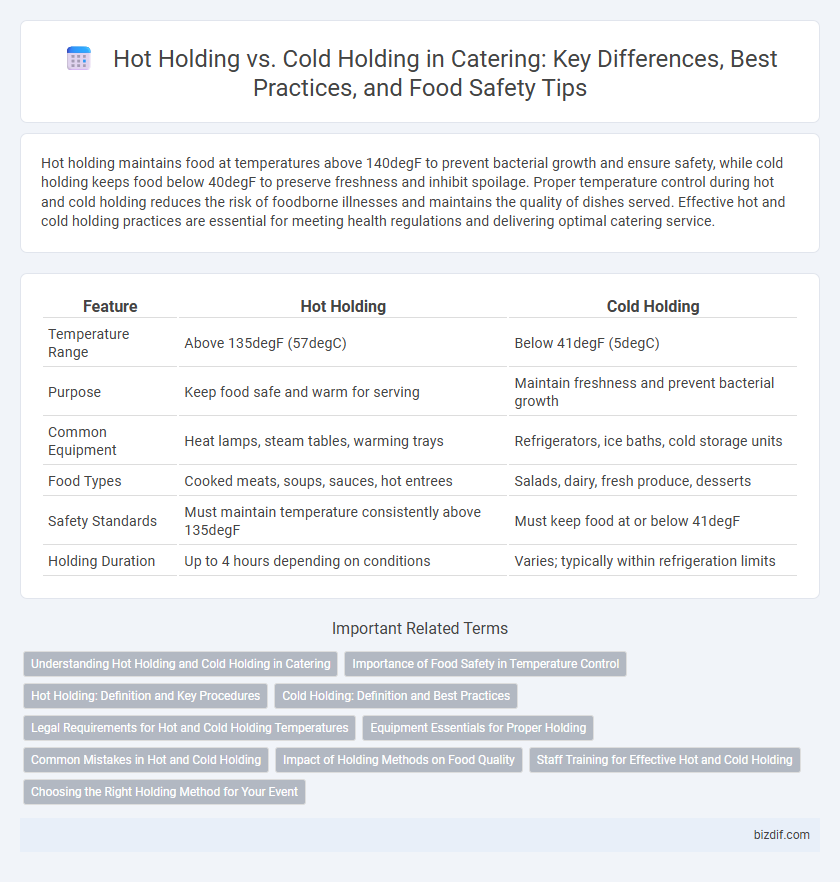Hot holding maintains food at temperatures above 140degF to prevent bacterial growth and ensure safety, while cold holding keeps food below 40degF to preserve freshness and inhibit spoilage. Proper temperature control during hot and cold holding reduces the risk of foodborne illnesses and maintains the quality of dishes served. Effective hot and cold holding practices are essential for meeting health regulations and delivering optimal catering service.
Table of Comparison
| Feature | Hot Holding | Cold Holding |
|---|---|---|
| Temperature Range | Above 135degF (57degC) | Below 41degF (5degC) |
| Purpose | Keep food safe and warm for serving | Maintain freshness and prevent bacterial growth |
| Common Equipment | Heat lamps, steam tables, warming trays | Refrigerators, ice baths, cold storage units |
| Food Types | Cooked meats, soups, sauces, hot entrees | Salads, dairy, fresh produce, desserts |
| Safety Standards | Must maintain temperature consistently above 135degF | Must keep food at or below 41degF |
| Holding Duration | Up to 4 hours depending on conditions | Varies; typically within refrigeration limits |
Understanding Hot Holding and Cold Holding in Catering
Hot holding in catering maintains cooked food at temperatures above 60degC (140degF) to prevent bacterial growth and ensure food safety during service. Cold holding involves keeping perishable foods chilled below 5degC (41degF) to inhibit microbial activity and preserve freshness. Proper temperature control in both hot and cold holding is critical for compliance with food safety standards and minimizing the risk of foodborne illnesses.
Importance of Food Safety in Temperature Control
Maintaining precise temperature control in catering is crucial for food safety, as hot holding above 140degF (60degC) prevents bacterial growth, while cold holding below 40degF (4degC) slows pathogen multiplication. Improper temperature management can lead to foodborne illnesses, emphasizing the importance of consistent monitoring with calibrated equipment such as thermometers and insulated containers. Ensuring strict adherence to hot and cold holding standards protects consumer health and complies with regulatory food safety guidelines.
Hot Holding: Definition and Key Procedures
Hot holding in catering refers to maintaining cooked food at temperatures above 140degF (60degC) to prevent bacterial growth and ensure food safety. Key procedures include regularly monitoring food temperature with calibrated thermometers, using insulated containers or heated cabinets, and avoiding temperature fluctuations during service. Proper hot holding also involves timely reheating and minimizing open-air exposure to maintain quality and reduce contamination risks.
Cold Holding: Definition and Best Practices
Cold holding refers to the practice of keeping perishable food items at safe temperatures, typically below 41degF (5degC), to inhibit bacterial growth and maintain freshness. Best practices for cold holding include using proper refrigeration units, regularly monitoring temperatures with calibrated thermometers, and minimizing the time food spends outside safe temperature zones. Ensuring airtight storage and avoiding overloading refrigerators further enhances cold holding effectiveness, preventing contamination and preserving food quality in catering operations.
Legal Requirements for Hot and Cold Holding Temperatures
Legal requirements for hot holding mandate maintaining food at or above 135degF (57degC) to prevent bacterial growth, while cold holding standards require keeping food at 41degF (5degC) or below to ensure safety. Foodservice facilities must adhere to these temperature regulations as specified by the FDA Food Code and local health departments to avoid violations and reduce the risk of foodborne illnesses. Proper monitoring with calibrated thermometers and documented temperature logs is essential for compliance during catering events.
Equipment Essentials for Proper Holding
Proper hot holding equipment such as steam tables, warming drawers, and insulated containers maintains food temperatures above 135degF to prevent bacterial growth and ensure food safety. Cold holding requires refrigerated units, ice baths, or chilled display cases that keep perishable items below 41degF to preserve freshness and prevent spoilage. Using calibrated thermometers and insulated transport carriers further supports maintaining safe food temperatures during service and transport.
Common Mistakes in Hot and Cold Holding
Common mistakes in hot holding include maintaining temperatures below 135degF (57degC), which promotes bacterial growth and compromises food safety. In cold holding, errors often involve storing food above 41degF (5degC), leading to spoilage and increased risk of foodborne illness. Improper monitoring and inconsistent temperature control are critical issues affecting both hot and cold holding in catering operations.
Impact of Holding Methods on Food Quality
Hot holding preserves food safety by maintaining temperatures above 140degF, preventing bacterial growth and retaining moisture, texture, and flavor. Cold holding slows microbial activity by keeping food below 40degF, preserving freshness and preventing spoilage but can risk texture changes like sogginess or drying. Improper holding methods compromise food quality by accelerating nutrient loss, altering taste, and increasing the risk of foodborne illnesses.
Staff Training for Effective Hot and Cold Holding
Effective staff training in catering ensures proper hot holding and cold holding techniques to maintain food safety and quality. Training emphasizes temperature control, with hot holding kept above 140degF (60degC) to prevent bacterial growth and cold holding below 40degF (4degC) to preserve freshness. Regular staff assessments and practical demonstrations enhance compliance with health regulations and reduce foodborne illness risks.
Choosing the Right Holding Method for Your Event
Selecting the appropriate holding method depends on the type of food being served and the event duration to ensure optimal safety and quality. Hot holding maintains cooked foods at temperatures above 140degF (60degC) to prevent bacterial growth, ideal for soups, casseroles, and meats. Cold holding keeps perishable items below 40degF (4degC), preserving freshness for salads, desserts, and dairy, making the choice crucial for food safety and guest satisfaction.
Hot Holding vs Cold Holding Infographic

 bizdif.com
bizdif.com